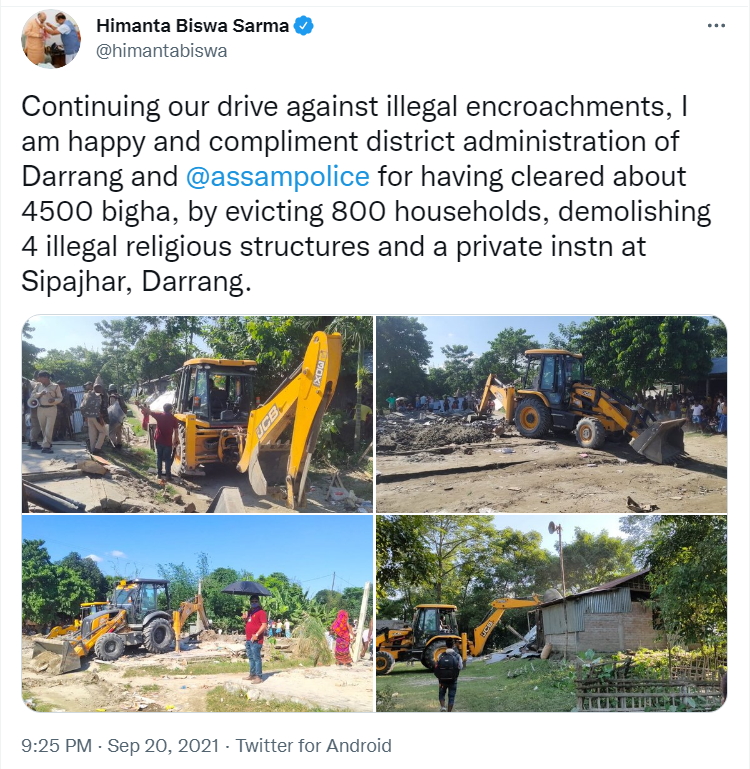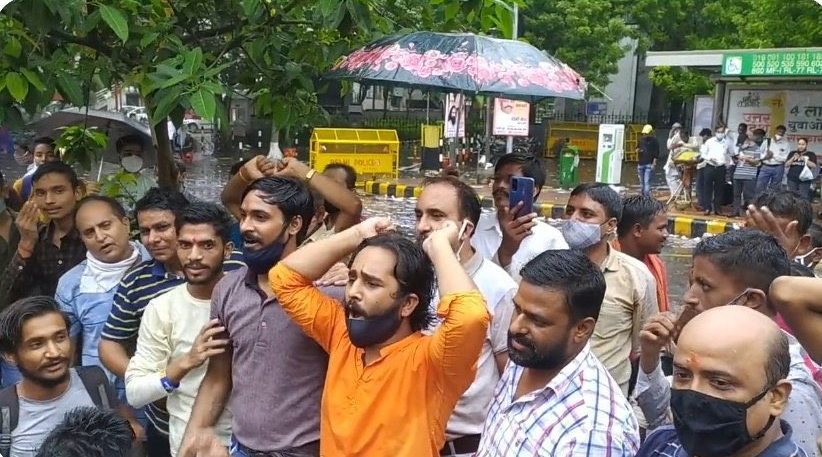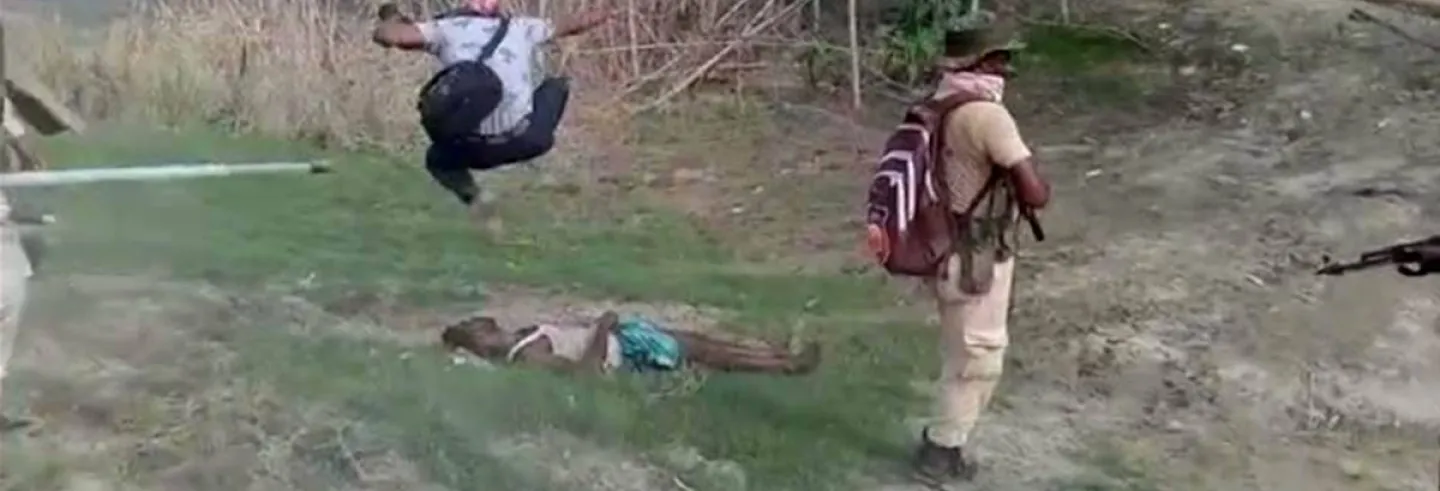A viral video clip of 1.12 minutes from Assam, shot on 23 September during police action to remove settlers from government land, has to be viewed from the first second to the last to understand the meaning and nature of the violence encapsulated in it.
There are scores of policemen with firearms. There are sounds of gunshots. You cannot see the target. Two policemen run towards the camera, a frail man with a raised stick behind them.
The man runs into the band of armed policemen. They surround him. Their batons rain on him. The man cannot be seen now. What appears then is a policeman with his fingers on the trigger of his gun.
And the fallen man.
He is almost motionless but there is still life in him. The camera zooms in on him.
Into the frame enters a running man holding a camera. The cameraman jumps on the man felled by the bullets of the state. A policeman joins him, hitting the barely alive man. The cameraman returns to jump on the fallen man and hits him again.
The head of the fallen man, which was facing the sky above, slumps to the side.
There is noise. Some policemen gently lead the cameraman away. You can see that he is agitated. The camera follows the cameraman. He is surrounded by the policemen. One of them hugs the cameraman. You understand that he is being comforted.
Beyond routine brutality
According to Chief Minister Himanta Biswa Sarma, the violence that the video clip captured was only a reaction to the violence from the ‘encroachers’, the cameraman being “an aberration”. The government of Assam says that it is duty-bound to free the land from the encroachment of ‘outsiders’. Justifying the police action, including the firing, Sarma asked why the ‘encroachers’ resisted the police force.
This was not a simple exercise to maintain law and order. There was something more to it.
Police across India are generally not very kind to the poor. Even by those standards, as N.C. Asthana, a former police chief, notes, the nature of firing in this case is exceptionally vicious:
The absolutely wanton manner in which the police personnel were seen firing at chest height at civilians as if they were doing some target practice was absolutely unprecedented in the history of the country and could probably put even the Jallianwala Bagh firing to shame.
Asthana tries to understand the reason behind this bloodthirstiness:
Some people on social media have attributed the brutality to Islamophobia and hate enabled by the state as the targets were Muslim ‘immigrants’. At present, however, we do not have the exact and detailed sequence of events, which could be suggestive of the psychological reasons of the wanton firing by the policemen. In all fairness, therefore, we must reserve judgment on this aspect for now.
As a professional policeman, Asthana is disturbed by the fact that in this case the police went beyond their brief and looked like an interested party that wanted to destroy the Muslims. This was not a simple exercise to maintain law and order. There was something more to it. What could that be? What drove the wrath of the police?
To understand this, we need to recall the brutal police action across Delhi and Uttar Pradesh in December 2019 on protesters against the Citizenship Amendment Act (CAA) and the National Register of Citizens (NRC), many of whom were Muslim. The police barged into the library and hostels of Jamia Millia Islamia and the Aligarh Muslim University, used stun grenades, broke furniture, and humiliated students with anti-Muslim slurs and by parading them with their hands raised.
In Uttar Pradesh, the government responded ferociously to protesters by barging into the homes of Muslims and torturing members of the community. More than 20 deaths were reported. Most of them had died of gunshots. What was most disquieting was that the government blamed the deaths on the protesters themselves. Even after such large-scale violence neither the government nor the courts thought it fit to get it investigated. More than 800 people were jailed. Many are still languishing in prison.
The vehemence of the police action across these states tells you why Assam is not an exception. What is also common between Uttar Pradesh and Assam is that the chief ministers did not express any regret or sorrow over the death of their people, though they were citizens of India.
The chief minister of Uttar Pradesh said the state would take revenge on those protesting against the CAA. Protesters were always described as arsonists. In Assam, the chief minister insisted ‘outsiders’ would have to vacate land for ‘indigenous’ people and was livid that the residents had dared to resist his demolition squad.
Appeasing ‘indigenous’ anger
All governments justify and defend their anti-encroachment drives, but in this case, the chief minister announced it on Twitter with a satisfaction that delivers a message:

Note the mention of illegal religious structures. What could be the reason for this treatment of evicted people and the protestors?
The name of the person killed by the police in Assam is Moinul Haque. The name of the cameraman jumping on his body is Bijoy Bania. These names decode the cunning and message not-so-hidden in the words, ‘outsider’ and ‘indigenous’. Despite being an Indian citizen and having documentary proof of that status, Haque remains an outsider, with no claims to sympathy. He has to vacate land for the ‘insider’, the ‘indigenous. Bijoy Bania is the ‘indigenous’ whose anger has to be understood and rationalised, even if his actions themselves may not be approved.
Violence against Muslims is justified by giving it a supposed rationale. They are not attacked for being Muslims, so the arguments go: they are doubtful citizens.
Across India, there are Bijoy Banias roaming around looking for Moinul Haques. Islamophobia is too mild a term to describe the relentless violence, physical and psychological, collective, and individual, faced by Muslims over the last seven years, at the hands of the state’s administrative and police machinery, and through the judiciary.
Non-state actors too are confident that they will be protected if the target of their violence are Muslims. The media, irrespective of the languages it operates in, promotes, and endorses this violence. The corporate leaders of India have quietly supported this anti-Muslim politics by financing it liberally.
The violence against Muslims erases their existence and makes them visible in the most obscene manner. Hatred and violence against Muslims is justified by giving it a supposed rationale. They are not attacked for being Muslims, so the arguments go: they are doubtful citizens, illegal migrants, encroachers, infiltrators, Bangladeshis, Rohingyas, outsiders, traitors, terrorists, anti-nationals, or fundamentalists. It is not difficult to see that these terms are mere cover for the word ‘Muslim’. When leaders utter these words, the followers decode them effortlessly.
Criminalising a community
Hindus are being told that Muslims are waging ‘economy jihad’ and therefore they must be boycotted economically. Attacks on Muslim business are now becoming routine. The idea is to deprive them of their livelihood. Video clips have shown hundreds of people roaming around in Khargone, a Madhya Pradesh, asking Muslim shop owners to shut their shops. Muslims were attacked and their belongings were damaged. Slogans of “shoot the traitors” were raised by the marauding crowd. We saw crowds attacking Muslim fruit sellers in Uttam Nagar in Delhi. Before that, news of Muslims asked not to apply Henna to Hindu women in the month of Shrawan, which is a custom in the northern part of India, came from Muzaffarnagar. The image of a Muslim bangle seller being assaulted for having dared to enter a Hindu locality in Indore became national news but most of us should have known that it was bound to happen. In the first phase of Covid-19, Muslims were blamed for spreading the disease and Muslim vendors were turned away from Hindu localities and even attacked. Many were pushed out of business permanently and had to find other work.
All aspects of Muslim life are defamed, criminalised. Everyday acts are portrayed as part of a collective conspiracy.
A convenient way of crippling Muslims economically is to ban meat and slaughterhouses. The UP government did it forcing thousands of them into misery as it affected many other areas like tannery and shoe production. The UP government has now announced a ban on meat in Mathura, calling it a holy city of Hindus. The Assam chief minister did it in a more devious manner. Selling and consumption of meat within 5 km. of temples or holy places of Jains and Sikhs have been outlawed in Assam. His plea is that there are many Muslim-dominated areas and they are free to sell, and eat meat in those areas. What he is proposing is the permanent segregation of Hindus and Muslims. Critics pointed out that anyone can build a temple anywhere and the meat ban rule could thus be extended to any place. There are temples in many Muslim-dominated villages. What about them? In the same legislation, The Assam Cattle Preservation Bill, so many restrictions have been put that people would be forced to leave the business of cattle trading altogether.
Muslims not getting houses in Hindu-dominated areas is not news anymore, and yet when two Muslims legally bought houses in Meerut, an agitation started calling it ‘land- jihad’ by Muslims. Five years ago when Muslims were attacked and prevented from offering their collective Friday namaz in an open space in Gurgaon, a state government minister alleged that Muslims did it with the aim of capturing land.
All aspects of Muslim life are defamed, criminalised. Everyday acts are portrayed as part of a collective conspiracy. The popular anchor Sudhir Chaudhary of Zee TV in March 2020 took to air to enumerate the supposedly many ‘jihads’ Muslims were waging against Hindus: ‘love-jihad’, ‘population jihad’, ‘land jihad’, ‘economic jihad’, ‘history jihad’, and ‘media jihad’. Later that year, Sudarshan TV accused Muslims of waging a ‘UPSC jihad’ with an aim to fill the civil services.
So-called ‘jihad’ is a popular conspiracy theory in south India too. Recently, a Catholic bishop in Kerala warning his followers that their women and youth were being targeted by Muslims using what he claimed as ‘love jihad’ and ‘narcotics jihad’. Despite criticism, neither he nor his church withdrawn the claim.
Pinarayi Vijayan, the chief minister of Kerala initially tried to minimise the seriousness of the bishop’s statement, saying a case could not be registered against what Vijayan called a private opinion expressed before the followers of his church. (Vijayan later criticised the bishop’s remarks). It must be remembered that claims of ‘love jihad’ have been given weight not only by the church but also by the CPI(M). In 2010 when the then chief minister V.S Achuthanandan accused Muslim organisations of conspiring to increase the community’s population through love-jihad.
This vicious propaganda against Muslims has serious implications. Recently, in Kerala, calls were given to boycott two Muslim owned food processing companies. But it can be even more serious, fatal for Muslims. Since they are a threat to Hindus and India, they are fit to be disciplined or eliminated. It is even seen as a patriotic duty. A 15-year-old Junaid can be killed in a train journey and the accused can roam around freely.. We now even have open calls for mass murder of Muslims even in the heart of India’s capital in the presence of the police.
A lack of solidarity
Muslims should not expect any political demonstration of solidarity from as mainstream parties fear such acts might alienate Hindus. The Aam Admi Party not only distanced itself from the Shaheen Bagh movement, it actively vilified it calling it a conspiracy by the BJP. When Muslims were attacked in the violence in February 2020, AAP leaders refused to offer them relief and support.
Across states, violence against Muslims is carried out through the enactment of discriminatory laws. Freedom of Religion Acts, now in force in many states, purportedly to stop forcible conversion, are actually an attack on Muslim men’s choice of partners. The Triple Talaq law singles out Muslim men for criminalisation. Laws prohibiting cattle trade and beef criminalise professions and eating habits of Muslims, even in places like Lakshadweep where 93% of its population are Muslim. In Bihar a High Court order to build detention centres for ‘illegal migrants’ has led the state to encourage vigilantism to identify infiltrators. We should not be surprised if Bihar goes the Assam way.
Muslim leaders can never dream of any prominence in political parties. They should not be seen active as it can scare Hindus, is the argument of the secular parties. They fear that any political activity with a Muslim face would be termed ‘communal’. Thus, Muslim politicians are condemned to play second fiddle to Hindu leaders and remain relegated to the minority cells of their parties. Voters in Gujarat and Assam were warned by the BJP that voting for the Congress would give the respective states Muslim chief ministers.

The Islamophobia of the left gets expressed in different ways. Way back in 2002, after taking over as the chief minister of West Bengal, Buddhadev Bhattacharya expressed concern over the madrasas in the border areas indulging in “anti-national” propaganda. He had no evidence to substantiate his claim, but he never withdrew it. The scepticism towards Muslims remained.
Analysing the strategy of the CPI (M) in Kerala, Ayyapan R noted how the image of extremist Muslim is used by the party:
to humour the openly secular but secretly communal Hindu. It created a villain, the Extremist Muslim, and flogged it publicly. The spectacle was clearly intended for the satisfaction of the ‘half-way Hindu’ who did not want to be seen with the Sangh Parivar crowd but still had found merit in the wild fears they had raised about the Muslim.
The figure of the extremist Muslim is very useful. It allows the CPI (M) to be sympathetic to Muslims, to pass a resolution against the discriminatory Citizenship Amendment Act, and also take a “principled stand” against extremist Muslims. How can anyone criticise a government which is against extremism?
Making visible in order to erase
Islamophobia in India erases Muslims even as it hyper-visiblises them. We see them being mocked, attacked, humiliated, and even killed. This visibility further demoralises and diminishes the worth of Muslims in their own eyes. A political erasure disempowers them. The names, symbols with Muslim association are gradually and symmetrically being wiped out from public memory. Their Indian citizenship is challenged. They are asked to face all this silently.
The seriousness of Islamophobia is undermined by saying that hate campaigns are a means to distract Hindus from the ‘real’ economic issues.
When Muslims protest acts of violence, it is seen as a conspiracy against the nation and the state. Criminal cases are slapped on them and they are arrested, as has happened in Uttar Pradesh, Delhi, Indore, Assam, and elsewhere. Ironically, even secular minded people ask Muslims to ignore hate campaigns against them as it would give prominence to the spreaders of the hate. Often the seriousness of Islamophobia is undermined by saying that hate campaigns are a means to distract Hindus from the ‘real’ economic issues. Muslims are asked to focus on ‘real issues’.
Even a political thinker like Suhas Palshikar advises political leaders that they should tell their constituents about the larger threat to the ‘Idea of India’ rather than the marginalisation of and violence against Muslims as it would be, in his opinion, a self-limiting exercise. But political leaders do not need Palshikar to frame their discourse. They are a step ahead. The journalist Alishan Jafri points out that no political leader from any political party has even once spoken about the Islamophobia that has so visibly overrun the land. Muslims are often called oppressed and marginalised, or even minorities, but the word ‘Muslim’ is now conspicuously absent in the political discourse of India.
Islamophobia works in many ways in our daily lives. In textbook and schools ‘us’ is Hindu and ‘them’ Muslim. While talking about Indian culture and civilisation, we cite Vedas, Upanishads, Ramayana, and Mahabharata as its sources. Political leaders vie with each other to look as ‘authentic’ Hindus and shun all kinds of Muslimness. The Hindu religion is praised for its openness and for not being a book-based religion like Islam. Even when we extol Indian Islam, we ask Indian Muslims not to get influenced by the Islam practised outside India. We patronisingly applaud Indian Muslims for resisting radicalisation. We approvingly tell someone that she does not look like a Muslim. We treat the burqa as a violent expression, as violent as a trishul. We lament the supposed absence of liberal and modern leadership in the Muslim community.
What is encouraging is the refusal of the Muslims to take it lying low.
In this dismal state, what is encouraging is the refusal of the Muslims to take it lying low. What started as the anti-CAA protests, which was to assert the claim of Muslims over India as equal partners, has grown into multifaceted activism. We have young Muslim women and men, as journalists, as student and youth activists who are tirelessly bringing this Islamophobia to the notice of the world, constantly challenging the executive, legislature, and the judiciary that they still have a constitution to follow. Even in the face of insult and humiliation, Muslims are not silent. Hopefully they would give some of their courage to the secular polity of India to find its ethical spine and to Hindus to discover their humanity.










